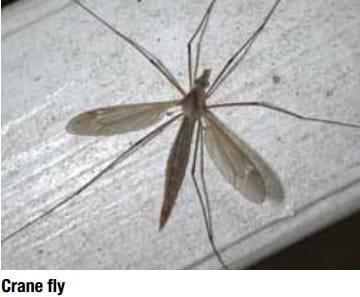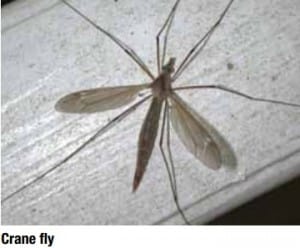 Crane flies (Tipulidae): Crane flies (Tipulidae):
Crane flies have long legs, a long slender body, and vary in body length from 1/16 to 1 inch. Some crane flies may resemble large mosquitoes. Color will vary depending on species, but one common species is light brown or tan. The larvae are called leatherjackets and can damage lawns by feeding on the roots of grass.
Habits: Crane flies generally rest with their legs spread widely. Adults feed on nectar or do not feed at all; many have vestigial mouthparts. Once they become adults, most crane flies simply mate and die, all within a few days. They do not bite humans.
Interventions: No action recommended.
Might Be Confused With: mosquitoes. |
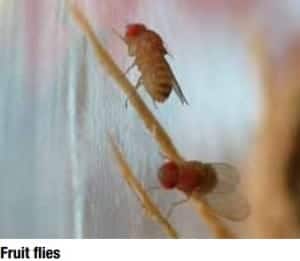 Fruit flies (Drosophilidae): Fruit flies (Drosophilidae):
The most common species have red/orange eyes, but not all fruit flies have red/orange eyes. Fruit flies often hover around and just above food (most often decomposing vegetable matter) prior to landing. Flies are 1/8 inch.
Habits: Feed mainly on decaying vegetable matter, compost, rotting fruit, etc. Often found around salad bars and restaurants where vegetable matter and juices collect. Also called vinegar flies, since vinegar (acetic acid) is a decomposition product of some rotting vegetable matter.
Interventions: Find larval fly feeding site(s) and clean or otherwise throw away rotting fruit or vegetable matter. Remove garbage, including the plastic liner, and other refuse at least twice per week.
Might Be Confused With: humpbacked flies, fungus gnats, moth flies. |
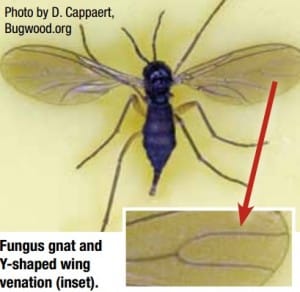 Fungus gnats (several families represented; mostly Sciaridae): Fungus gnats (several families represented; mostly Sciaridae):
Small (1/16 inch) fly with smoky black wings. Y-shaped wing venation is characteristic.
Habits: Often found in over watered plants indoors or in otherwise wet conditions.
Interventions: Find larval fly feeding site(s) and clean or otherwise dry out. If desired, apply a soil drench with an appropriately labeled liquid insecticide.
Might Be Confused With: mosquitoes, fruit flies, humpbacked flies, moth flies. |
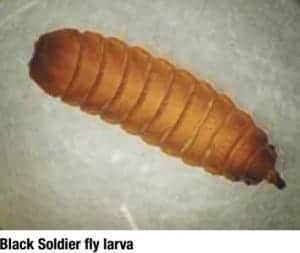 Black Soldier flies (larva) (Stratiomyidae): Black Soldier flies (larva) (Stratiomyidae):
Strongly-segmented larva, 3/4 to 1 inch, with two 1/16 inch protrusions from one end. Adult flies rarely seen, but are 3/4 inch and appear wasp-like and with two clear spots on upper abdomen.
Habits: In homes, larvae usually found in the bathroom. Presence in bathroom may be indication of sanitary (sewer drain or septic tank) problems because larvae feed in putrid, wet conditions. This insect also lays eggs and larvae develop in piles of damp organic matter such as compost piles. Like many fly species, larvae are known to wander well-away from their breeding site into areas where they pupate.
Interventions: Find the larval food source and address the problem by sanitation or moisture management.
Might Be Confused With: adults look like wasps. |
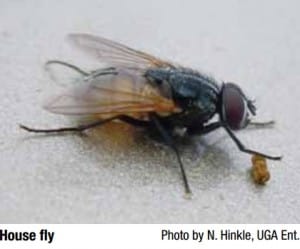 House flies (Muscidae: Musca domestica): House flies (Muscidae: Musca domestica):
The most recognizable of all fly species. Black, drab, 1/4 inch, fast-flying, often numerous around garbage cans and related refuse areas.
Habits: Breeds in garbage, trash, animal waste, and other organic refuse. Like most flies, found most frequently breeding in overly liquid or wet conditions. Often associated with unsanitary, unkempt conditions, such as areas abundant in animal waste or human garbage/landfills. The term maggot is most commonly used in reference to this fly’s larval stages. Because flies are pushed by prevailing, local winds, their source may be from some distance away.
Interventions: Proper sanitation and exclusion is an effective means of reducing fly numbers. Indoors deploy and maintain sticky traps associated with attractive lights (commercial insect light traps) and/or the chemical attractant Z-9-tricosene. Be sure that indoor light traps are situated so that they cannot be seen by flies from the outside. There is no scientific evidence to support claims that a hanging bag full of water serves as a deterrent to house flies. Remove garbage and other refuse at least twice per week.
Might Be Confused With: blow flies. |
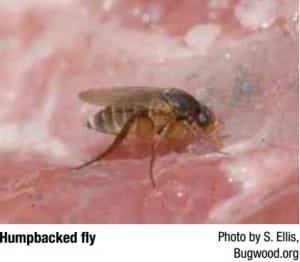 Humpbacked flies (Phoridae): Humpbacked flies (Phoridae):
Also referred to as scuttle flies or coffin flies. Often scuttle about on the surface around and on infested materials. Humpbacked flies are about 1/8 inch.
Habits: Often associated with dead and decaying animal or plant matter (e.g., dead insects, rotting potatoes), bacterial buildup in drains (drain and sewer scum) in bathrooms and kitchens, and in/around garbage cans.
Interventions: Find and clean fly breeding sites and/or clean out drains. Make certain that the water trap in the drain line (especially common in less frequently used sinks) is filled – if the water trap dries out, flies and other pests that live in the drain lines will be able to enter the building. Remove garbage and other refuse at least twice per week.
Might Be Confused With: fruit flies, moth flies, fungus gnats. |
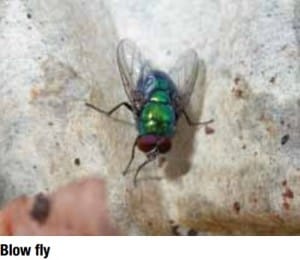 Blow flies (Calliphoridae: many species): Blow flies (Calliphoridae: many species):
Also referred to as bluebottles and greenbottles. Large, robust, fast-flying flies, 1/4 to 3/8 inch, commonly shiny and with metallic blue, green, copper, or gray coloration. Some species strongly bristled, some with stripes on their pronotum (upper thorax), and some with large, reddish-brown eyes. Resemble house flies in their flying behavior.
Habits: Flies attracted to and breed in recently dead and decaying animals and animal waste. When suddenly present in large numbers, and when present indoors (typically at windows sills), is highly suggestive of a dead animal indoors (e.g., attic, crawlspace, wall void, fireplace, etc.).
Interventions: Find dead animal and remove it. Maintain window and door screens to prevent entry into the house. Remove garbage and other refuse at least twice per week.
Might Be Confused With: house flies (especially the maggots). |
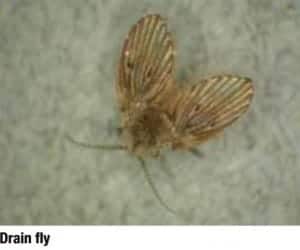 Drain flies (Psychodidae: Psychoda spp.): Drain flies (Psychodidae: Psychoda spp.):
Also referred to as moth flies. Oblong or oval, appears moth-like, and is about 3/16 inch, wings fuzzy. Larvae up to 3/8 inch.
Habits: Commonly found in bathrooms (breeds in scum in drains, showers, overflows, toilet bowls, etc.). Adults rest motionless on walls until disturbed, and then fly well. Need wet conditions to breed. When toilets have gone un-flushed for an extended period, moth flies may lay eggs in the toilet tank, and larvae can be found there. When the toilet is finally flushed, larvae can make their way into the toilet bowl, where they are discovered.
Interventions: Clean the inside of the drain of all scum and detritus using a mild cleanser and a bristled brush. Never pour insecticides into drain. Pouring bleach into drains is not effective. Make certain that the water trap in the drain line (especially common in less frequently used sinks) is filled – if the water trap dries out, flies and other pests that live in the drain lines will be able to enter the building. To help determine whether a particular drain is infested, place a clear cup, inverted, over the drain. If flies emerge from the drain, they will be trapped by the cup, and can be seen.
Might Be Confused With: fungus gnats, humpbacked flies, fruit flies, and small moths. |
